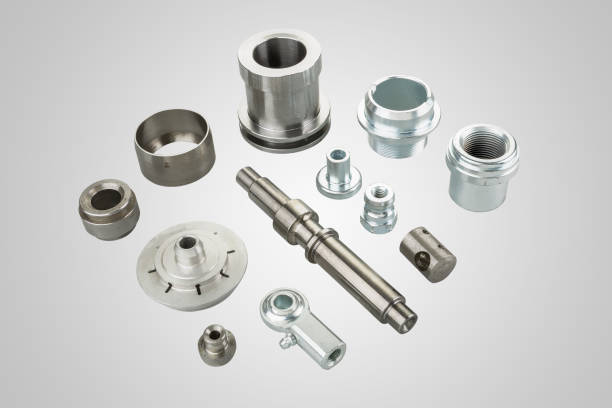Machined Parts refer to components processed from raw materials (such as metals, plastics, composites, etc.) through various mechanical machining methods to achieve specific shapes, dimensions, and precision requirements. These parts are widely used in numerous fields, including automotive, aerospace, electronics, machinery, and energy. With the continuous advancement of industrialization, the variety and applications of machined parts continue to expand, making them an indispensable part of modern industrial production.
- Main Types of Machined Parts
Machined parts can be categorized into different types based on processing methods and materials. Below are some common types:
- Turned Parts
Turned parts are components produced using a lathe. Turning involves cutting a rotating workpiece with a fixed tool, making it suitable for cylindrical and shaft-like parts. Common turned parts include shafts, sleeves, and discs, widely used in automotive, machinery, and electronics industries. These parts require smooth surfaces and precise dimensions.
- Milled Parts
Milled parts are manufactured using milling machines. Milling employs rotating cutting tools to shape workpieces, making it ideal for producing flat surfaces, grooves, gears, and other complex geometries. Milled parts are commonly used in machine components, molds, and other precision-engineered products.
- Drilled Parts
Drilled parts are components with holes processed using drilling machines or other equipment. Drilling is often used for precision hole machining, such as guide holes and threaded holes. These parts demand high accuracy, especially in electronics and aerospace applications.
- Ground Parts
Ground parts undergo surface grinding using grinding machines, making them suitable for components requiring high precision and superior surface quality. Grinding is typically used in final finishing stages and is prevalent in aerospace, automotive, and precision instrument industries.
- Cut Parts
Cut parts are produced through shearing, laser cutting, plasma cutting, or similar methods. These techniques are mainly used for sheet metal, pipes, and other relatively simple shapes. Due to their speed and cost-efficiency, cutting processes are widely applied in mass production.
- Applications of Machined Parts
As fundamental components in manufacturing, machined parts are widely used across various industries. Key application sectors include:
- Automotive Industry
The automotive sector heavily relies on machined parts for body frames, engine components, suspension systems, and transmission systems. Requirements include high precision, strength, wear resistance, and lightweight properties. Turned, milled, and ground parts are extensively used in this field.
- Aerospace Industry
Aerospace applications demand exceptionally high precision, strength, fatigue resistance, and heat resistance. Components like aircraft engines, structural parts, and navigation equipment require advanced machining techniques such as milling, drilling, and grinding.
- Electronics & Electrical Industry
Machined parts in electronics must meet high dimensional accuracy and surface quality standards. Examples include connectors, component housings, and heat sinks. With the rapid evolution of smartphones, computers, and appliances, demand for precision-machined parts continues to grow.
- Machinery & Equipment Industry
Machinery manufacturing relies on machined parts for transmission components, precision instruments, and automation equipment. Key requirements include structural reliability, durability, and dimensional accuracy.
- Energy Industry
The energy sector (oil, gas, power generation, etc.) requires robust, corrosion-resistant machined parts for turbines, pumps, valves, and pipeline fittings. High-quality machining ensures stable operation under extreme conditions.
- Medical Industry
Advances in medical technology demand ultra-precise components for surgical instruments, device housings, and implants. High-precision machining ensures safety and functionality in medical applications.
III. Quality Control & Technical Requirements
The quality of machined parts directly impacts product performance and safety, making quality control critical. Common methods include dimensional inspection, surface roughness testing, and hardness measurement. Additional processes like heat treatment and surface coating may be applied to enhance strength, corrosion resistance, and wear resistance.
- Dimensional Accuracy
A fundamental requirement, dimensional tolerances vary by application but are especially stringent in aerospace and electronics.
- Surface Quality
Surface finish affects performance, particularly in friction and wear applications. Grinding and polishing improve roughness and smoothness.
- Material Properties
Material selection determines durability and reliability. High-strength, corrosion-resistant alloys are essential for extreme environments, requiring consistent material quality.
Machined parts are vital to modern industry, serving diverse sectors from automotive to aerospace, electronics to energy. As machining technology advances, higher-precision and higher-performance components will emerge. Quality control remains paramount to ensuring reliability. In summary, machined parts play a crucial role in enhancing industrial efficiency, driving technological progress, and ensuring equipment safety.

